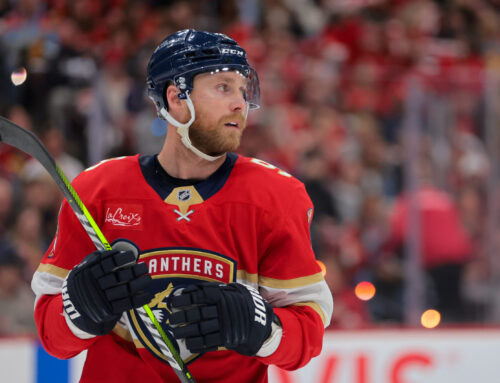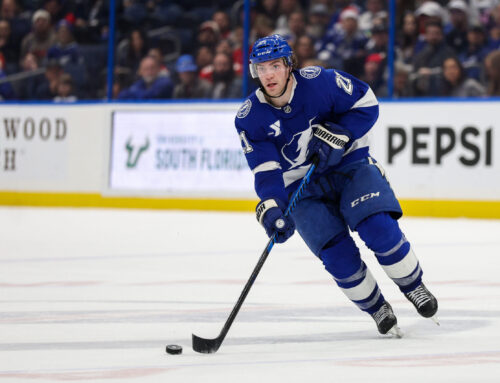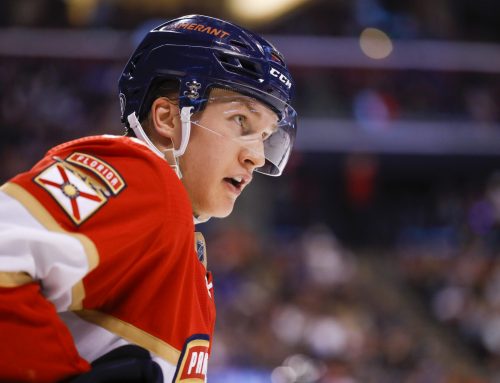Welcome back to Goldipucks and the Three Skaters, a play on words of the Goldilocks and the Three Bears story. Here though, instead of there being three bowls of porridge I’m covering three skaters and declaring one too hot (i.e., doing unsustainably better than he should), another too cold (i.e., doing unsustainably worse), and a third “just right” (i.e., producing where he should be). I also assign each a rating of 1-10, indicating just how hot (rated 7-10, where 10 is the most unsustainably hot), or how cold (rated 1-4, where 1 is the most unsustainably cold), or how “just right” (rated 4-7, where 5.5 is the most “just right”) he is.
In honor of Bubble Keeper Week, I'll be examining – what else – three Bubble Keepers. With Bubble Keepers, this column takes on arguably even more importance than normal, as these are players where a change in actual value versus perceived value stands to make more of a difference as to where – or even whether – they should be drafted in your leagues. The three skaters to be covered are Mattias Ekholm, Jake Virtanen, and Kyle Palmieri. As always, to see if your fantasy radar is accurate stop here to guess which of the three was too hot, who was too cold, and who was just right, then read on to see if you scored a hat trick by going three for three in your predictions.
While much of the fantasy attention surrounding Nashville blueliners is rightfully directed to Roman Josi and Ryan Ellis, Ekholm has quietly been a solid producer over the past five seasons, ranking 34th in cumulative points among all rearguards over that time frame, thanks to not only staying healthy but also being a pretty decent performer overall. The big question is whether we should count on him being a 45 point pace scorer (as we saw in 2018-19), a 40 point pace scorer (as we saw this past season), or a 35 point pace scorer (as we saw in 2017-18). Most likely at this point in his career, given his deployment, age, and the presence of those other two scoring rearguards, it would be safest to predict Ekholm coming closest to the 40 point pace from this past season.
Ekholm's metrics from 2018-19 and 2019-20 are remarkably similar, with him taking the ice for exactly 23:22 per game each season and with 1:20 of PP time for 2019-20 versus 1:22 for 2018-19. So why is the five-point full season scoring pace difference this past season versus 2018-19? That's tough to say. His SOG rate (2.26/game) was well higher in 2019-20 and in fact, marked an astounding seventh consecutive season of his SOG total increasing. On top of that, his IPP and OZ% were each just a tad lower. And the Preds as a team were more potent, averaging 3.07 goals per game versus 2.87 in 2018-19. So no clear answers.
Where the explanation might lie is in multi-point games. For 2019-20, he had 33 total points but a mere 30 games in which he scored a point, meaning he had only three games in which he scored two points and 27 where he tallied just one point. Compare that to the 2018-19 season, when his 44 points came in 35 games, and 2017-18, when his 34 points came in 26 contests. To put that in added context, the four other rearguards who each had 33 points in 2019-20 averaged 26 games with at least one point. So in other words, Ekholm's scoring seemingly should have been higher in the normal course in 2019-20 but wasn't due to him being unlucky in terms of how few multipoint games he had. This, coupled with his 2019-20 vs. 2018-19 metrics, would seem to point toward him being able to get back to the 45 point level again.
There's also the reality that Ekholm had his best output in 2018-19 when Ryan Ellis didn't miss a chunk of games. So the good news is even if both other better-producing defensemen are in the line-up, Ekholm can still shine. Or can he?
The mantra that there are only so many points to go around does appear to ring true here. In 2018-19, all three of Josi, Ekholm, and Ellis had 41+ points. Quite an accomplishment it turns out, as only five other times since 2000-01 had any team featured three defensemen who all posted 40+ points in the same season. And if we raise the bar to 45+ points for three defensemen from the same team, we get a mere one instance since 2000-01, which occurred more than a decade ago! So although if all three stay healthy it is plausible to imagine them each getting 40+ points yet again, it is far more of a stretch to envision them each tallying 45+. And with Ekholm consistently getting the worst deployment of the three when it comes to OZ%, the man advantage, and amount of shorthanded duty, chances are it would be his output which is curbed more so than that of Josi or Ellis.
Moreover, while Nashville's goals per game rate for 2019-20 increased versus 2018-19, the output of its three highest-scoring forwards from 2018-19 dropped in 2019-20. Where did those points go? While some middle-six forwards saw a per game scoring increase, it stands to reason points which those top forwards normally would've received were repackaged as defensemen points. Yet Ekholm's IPP dropped, so how does this make sense? For one, Josi and Ellis each saw IPP gains. Also, we have to look at secondary assists, as Ekholm's rate for 2019-20 was 36% and for 2017-18 was 33%, while for 2018-19 it was 56%, suggesting perhaps his scoring uptick that season was based on unsustainable luck after all and helping to explain why his points per game output dropped from 2018-19 to 2019-20.
Accordingly, if all three of Josi, Ellis and Ekholm are in the line-up and Nashville's top forwards bounce back to at least some degree, there will indeed be only so many points to go around, with Ekholm getting the shortest end of the stick. But it's still a pretty good stick, as he has shown he is capable of posting 40 points even with Josi and Ellis looming large. But to expect more given historical data, Ekholm's lack of PP time, and his best season coming when he had a high secondary assists percentage, and unsustainably poor forward scoring, is likely wishful thinking. Ekholm's 2019-20 was JUST RIGHT and his rating is 5.75, as he should be able to score at a 35-40 point pace for 2020-21.
Memes aside, let's not forget that Virtanen is a former sixth overall pick who'll be entering 2020-21 at age 24 and whose full-season scoring pace has improved in each of the past two seasons, from 22 points in 2017-18 to 29 in 2018-29 to 43 in 2019-20. Will he be like many a bigger player and thrive starting in his mid-20s, or has he reached his ceiling, or could he flame out altogether? Not only should Virtanen have tallied even more points last season, but thanks to offseason movement clearing a top-six spot for him, plus other factors, he's positioned to see yet another nice increase in production during the 2020-21 campaign.
With Tyler Toffoli leaving for Montreal and Josh Leivo for Calgary, there is an opening for a top-six RW in Vancouver, with Virtanen being the likely beneficiary. But is that good news? As it happens his most frequent linemates in his eight Q4 games were Bo Horvat and Tanner Pearson, and he had three points. With those his likely linemates should he be moved into the top six, that is not a great sign.
But other factors nevertheless suggest Virtanen is primed for scoring gains and should've had even more points in 2019-20. For one, he hit six posts and five crossbars, meaning he was inches away from at least a handful of extra goals. Plus, if we look at the list of NHLers who had 11 or more combined posts and crossbars it's a who's who of NHL stars, namely Leon Draisaitl, Patrick Laine, Auston Matthews, and teammate Elias Pettersson.
What Virtanen also had in common with star players was a high IPP, as was 83.7% in 2019-20. Who were the forwards directly above him in IPP: only three guys named Sidney Crosby, Evgeni Malkin and Patrick Kane. So although Virtanen's IPP was high due to playing with less talented players, if it drops somewhat by virtue of him skating with the likes of Horvat and Pearson he still likely would net points by the line scoring more goals overall.
Beyond these factors, Virtanen showed man advantage acumen despite limited PP time which was not on the top unit. Yes, his nine PPPts only tied him for 116th among all NHL forwards; however, he accumulated those PPPts in a grand total of 60:24 of PP time or an average of 53 seconds per game. That 60:24 of total PP time put him 241st among forwards, with only one player (teammate Adam Gaudette) ranked in the fifty spots ahead of Virtanen having more PPPts than his nine. With Virtanen having skill with the man advantage, plus his size, he could incent Vancouver to put him on the top PP unit as a net-front presence. Or even if that does not occur, between his and Gaudette's showings in 2019-20 the team might opt to allow its second unit to see more time in the normal course, rather than weighing it so much more towards those on PP1.
There's also the fact that 2019-20 marked Virtanen's third campaign of double-digit goals and assists yet also of scoring no more than 40 points, all by age 23. While admittedly some forgettable names also did so three or more times by that same age, so to did the likes of Radim Vrbata, Sean Couturier, Andre Burakovsky, James van Riemsdyk, Tomas, Hertl, Josh Bailey, Evander Kane, Kyle Turris and our third Bubble Keeper to be featured, Palmieri, each of whom has since gone on to post at least a season of 55+ points, with just under half having scored at least 70 points in at least one campaign. This lends credence to the idea that there still is a very realistic chance of Virtanen being a late bloomer.
So although Virtanen didn't shine when paired with his potential top-six linemates during a brief period, his 2019-20 output still was TOO COLD. Because of the multitude of factors noted above all pointing toward him not only deserving to have scored more points during last season but also getting more in 2020-21, he gets a rating of 2.0, since if Vancouver commits to him he could post 50-55+ points, with a shot at 60+ if somehow he can get a regular gig on PP1.
Since becoming a Devil in 2015-16, the team has struggled as a whole, with a mere one playoff appearance; however, Palmieri's production has not been negatively affected, as he has remarkably posted a full-season scoring pace of 54-58 points in each of those five campaigns. Set to turn only 30 this season and with the Devils likely icing a similar group of forwards as last year, should we just mark Palmieri down for that same scoring pace yet again? Not so fast…….
Despite the Devils needing all the scoring they could get, and Palmieri clearly qualifying as one of their top forwards, he shed over a minute of ice time from 2018-19 to 2019-20. He also fired fewer shots per game than in any of his previous seasons as a Devil. Although the team did not add anyone to supplant Palmieri during the offseason, the fact that he took the ice for less time in 2019-20 does not bode well for him to rebound to see more ice time in 2020-21; and perhaps he might even be further deemphasized, making it an uphill climb for him to keep up his usual scoring pace.
Beyond that, his shooting percentage, although always quite good, was 16.1%, which was well above his cumulative average of 13.0% during his prior four seasons with New Jersey, translating to five more goals he should not have received. Plus, it wasn't that he took better quality shots, as his ratio of shots from 0-30 feet for 2019-20 was roughly the same as it was for the 2019-20 campaign.
He also tied his Devils high of 55.0% secondary assists in 2019-20, with the cumulative average of his four prior seasons have been 47.2%. Moreover, he had a higher IPP than in either of his two prior seasons, albeit not by too much. The higher IPP was likely a function of Palmieri being a frequent linemate of Jack Hughes, who struggled to score and had an IPP of 50.0%, which is very low for a center. If Hughes and Palmieri stay on the same line for the 2020-21 campaign, chances are Hughes will fare better in his IPP, perhaps syphoning away points from Palmieri.
The other concern is Palmieri relies a lot on PPGs, having potted 11 in each of his last three seasons despite not scoring over 50 points in any one of those three campaigns. Yes, his 82 game scoring pace in each season was actually higher due to missed games; however, if we look at past player comparables it does not paint a pretty picture.
Going back to 2000-01, there have been only nine total instances of a forward having 11+ PPGs at age 26-28 (i.e., Palmieri's hockey age over the past three seasons) despite, also like Palmieri, scoring 50 or fewer points. And looking at the nine who did so (Tyler Bozak in 2014-15, Troy Brouwer in 2013-14, Johan Franzen in 2007-08, Brian Gionta in 2006-07, Jan Hrdina in 2002-03, Evander Kane in 2019-20, Milan Lucic in 2016-17, Mark Parrish in 2005-06, and Wayne Simmonds in 2014-15), we see that while some of them had another subsequent productive season or perhaps two, several had none.
And these were players who met these criteria once, compared to Palmieri having done so three times. As such, it might be that Palmieri, in having accomplished the feat three times, has used up the other good seasons that some of these players subsequently had. Yes, many of these players indeed logged more games than the 62, 74, and 65 than Palmieri did over his three most recent seasons, making it not true apples to apple comparison; however, I still believe it underscores that Palmieri relying on PP goals for so much of his scoring does not bode well for him to continue to produce at his current rate.
There's also the reality that Palmieri's style of play is changing, as his Hits total has dropped with each passing season in New Jersey. With him being less of a "banger" he might not be the ideal player to keep on a top-line to protect his fellow forwards. Moreover, that might start to negatively impact his PP scoring, as he will no longer be able to cast as imposing of a shadow.
Consistency in fantasy hockey is great until it stops. Accordingly, it's not a question of if but when Palmieri will slow. And for the first time since he embarked upon this streak of 54-58 point pace seasons, signs are suggesting that he might be due for a downturn. In fact, even his 2019-20 was TOO HOT based on his lower SOG and TOI and continued reliance, at his age, on much of his points coming in the form of PPGs. Palmieri is assigned a rating of 7.75, suggesting for 2020-21 his scoring pace likely will be at or slightly below 50 points, with a going-forward trajectory which might mirror that of Wayne Simmonds, who was one of the nine-player comparables noted above and also had been a remarkably consistent player who excelled on the PP until suddenly, at age 30 – which is how old Palmieri will turn during the coming season – his downturn started.
************
Questions for Mailbag column
I require more mailbag questions, and you can go ahead and send me yours by either private messaging “rizzeedizzee” via the DobberHockey Forums or, instead, by sending an email to admin@dobbersports.com with “Roos Mailbag” as the subject line.





 EDM
EDM STL
STL ANA
ANA BUF
BUF DET
DET NYI
NYI MIN
MIN CAR
CAR CBJ
CBJ L.A
L.A
